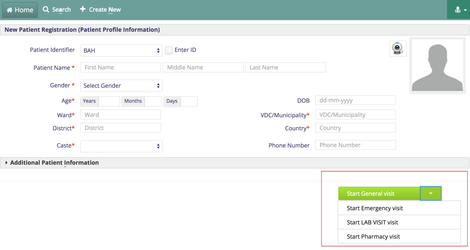Visits, Encounters and Locations
- Read this excellent explanation by Burke from OpenMRS team on the difference between Visits & Encounters. Since Bahmni builds on top of OpenMRS, the underlying data model is the same. https://talk.openmrs.org/t/tele-consultation/37547/5?u=gsluthra
- Also read this discussion on "Encounter Session" concept introduced by Bahmni on top of OpenMRS also: https://talk.openmrs.org/t/associating-data-with-the-correct-encounter/38062
Visits
Bahmni allows users to categorize visits into different types. Having multiple types of visits help in various things.
- It can be used in reporting where you count visits by different types.
- It can be used to configure queues in other apps such as Clinical or Radiology.
Every visit created is associated to a particular location.For more information and setup refer Visit Location.
It is mandatory to set up at least one visit type for an implementation. Visit types will be shown as dropdown options when creating or editing a patient in Registration. Visit types can be added via the OpenMRS admin screen(Administration > Visits > Manage Visit Types) or via sql scripts.
All visit types will automatically show up in the Start visit button on the registration page.
Encounters
A visit can be associated with one or more encounters. Bahmni allows you to define multiple encounter types.
You could define encounter type for locations such as Pharmacy, Lab, Consultation room or for actions such as admission or discharge.
You can add encounter types using the OpenMRS admin screen(Administration > Encounters > Manage Encounter Types) or using the sql scripts.
Locations
You can add Locations using the OpenMRS admin screen(Administration > Locations > Manage Locations) or by using the sql scripts.
This locations are automatically populated in the dropdown when you log-in and in the change location drop down at the Home screen.
The Bahmni documentation is licensed under Creative Commons Attribution-ShareAlike 4.0 International (CC BY-SA 4.0)


